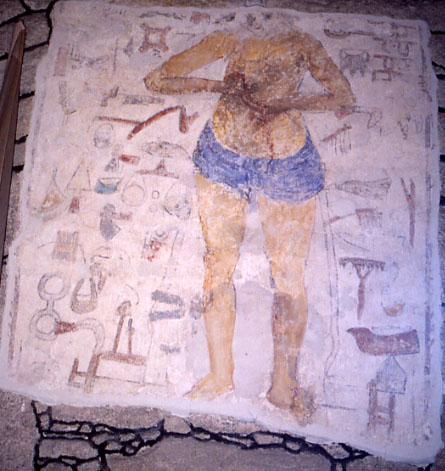St Just-in-Penwith, Cornwall (†Truro) C.15
Warning to Sabbath Breakers

The painting was uncovered in 1865 by builders doing restoration work in the church and inevitably the uncovering was done less carefully than it might have been. Large areas of plaster were hacked away, and the whole subject was repainted more or less immediately. Little attempt seems to have been made to follow the original lines drawn by the medieval painter, and the result must therefore be seen as a dubiously accurate Victorian repainting of a medieval original.
In particular, some of the implements now included might not have been here in the 15th century. Doubt has been cast on the balance or pair of scales for weighing (to the left of Christ’s right thigh). This is certainly not commonly found, but it is included among the implements at Poundstock where it has been accepted as original, rather than as a 19th century importation. Most of the other implements – the usual billhooks, scissors and shears, hammers, chisels and wool-combs occur regularly elsewhere, and can be regarded as medieval in inspiration at least But the bright blue of Christ’s loincloth certainly does not suggest a medieval pigment; it is much more likely to be Prussian blue, which came into use only in the 18th century.
As at nearby Breage, Christ indicates his wound, in this case with both hands, and a good deal of blood seems to be cascading from it. The articulation of his limbs, and indeed of his figure generally, is alarming clumsy; but this might be a consequence of the hasty repainting rather than lack of skill on the part of the original painter – the Christ figure in Warnings to Sabbath Breakers is executed with varying degrees of success as the examples in the table below testify. The figure at Poundstock is particularly awkward, perhaps because of an over-ambitious choice of pose.
It is unusual to find two examples of the Warning to Sabbath Breakers as close to each other as St Just and Breage, especially when, as mentioned above, there is a third relatively close by at Poundstock, but Cornwall is a large county, remote from centres of power, so this might be pure accident. There are other surviving subjects at both churches, and several other churches in West Cornwall – Sennen, St Keverne and Linkinhorne – also have paintings, including St Just in Penwith’s St George, repainted in the late 19th century in alarming pseudo pre-Raphaelite style.
† in page heading = Diocese